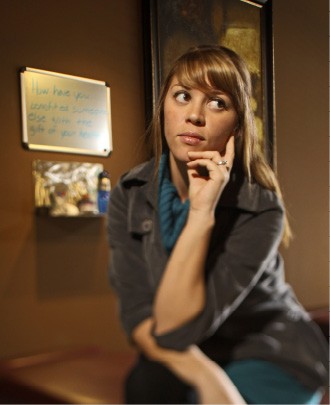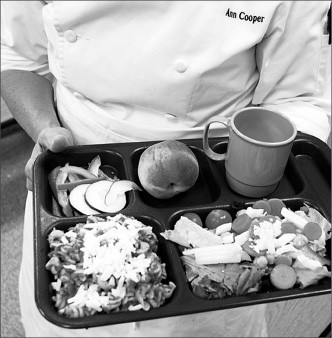In July 8, 2007, Grant Frank spent 36 hours at the Med. It cost him
$28,417.54.
At 4 a.m., he woke up to what he describes as “the worst pain of my
life.” He fumbled for his phone and called his father. “I’ve got to go
to the hospital,” he said. Soon, he was doubled over in the stark
waiting room of the Med, signing a form in which he verified his lack
of health insurance and agreed to pay off any medical bills to the best
of his ability.
After five hours in the waiting room, with the pain in his abdomen
getting worse, Frank was called to an examination room. He was
diagnosed with a gallstone, and because of the high toxicity of bile
stored in the gallbladder and the risk of rupture, doctors opted to
remove his gallbladder immediately. When he came out of surgery a few
hours later, Frank was given a brief convalescence in a semi-private
hospital room and was discharged by the end of that night.
“We got the bill a month later,” Frank said. “It said to pay as soon
as possible and that I could set up a plan, but all their plans were
things that I couldn’t do — like $400 a month. At that point, I
was making about $800 a month. My rent was $350, and my car insurance
was $125. With food and living expenses, it didn’t leave me much to pay
them.”
Frank is not alone in his experience. In 2008, 27 percent of
Americans age 18 to 34 were without health insurance, according to the
U.S. Census Bureau. That’s compared to 18 percent of those age 35 to
50. The highest concentration of uninsured adults are those age 20 to
25, a group typically undergoing the pivotal transition from parental
or university-based coverage to employment-based or private
insurance.
Jessamyn Bradley, 24, finished graduate school at the University of
Memphis in May 2009, but she hasn’t had insurance since well before
that.
“When I graduated from Middle Tennessee State University with my
bachelor’s, I was dropped from my parents’ insurance because I was over
18 and no longer a student,” Bradley said. “I guess that’s been about
three years, and it’s terrible, terrible, terrible. I haven’t had my
teeth checked in over two years, and whenever it’s time for an eye
exam, my mother foots the bill. And heaven forbid when it’s time for my
annual pap smear.”
Besides the risk of sudden illness, young adults have the highest
rate of injury-related emergency department visits. When an accident
happens or serious illness strikes, the uninsured and underinsured
(those who have some health coverage but are not protected from high
health costs) are left with medical bills they cannot pay. A 2007 study
by the American Journal of Medicine reported 62 percent of all
bankruptcy cases were medical-related. Even more startling, three
quarters of those debtors had some kind of health insurance.
 Justin Fox Burks
Justin Fox Burks
Burt Waller
Where the System Breaks Down
The status quo is bleak for patients and costly for providers. At
the Med, the Mid-South’s safety-net hospital, uninsured or underinsured
cases are far from unusual. The Med treats patients regardless of
coverage or ability to pay, not only patients from Memphis but from
throughout a five-state region. According to Judy Briggs, executive
director of revenue cycle, uninsured or “self-pay” patient visits made
up 31.8 percent of the hospital’s potential revenue for the 2009 fiscal
year. The hospital must absorb whatever portion of that revenue goes
unpaid.
When uninsured or underinsured patients receive treatment at the
Med, the hospital handles the billing process in a variety of ways. An
in-hospital representative from MedAssist checks to see if the patient
qualifies for Medicaid or Social Security. If the patient is the victim
of a crime, he or she could receive up to $30,000 in assistance from
the Crime Victim Fund. If the patient is below the poverty line, the
case could be considered “charity care.” If the patient does not fall
into one of these categories, he or she is responsible for setting up a
payment plan, like the one Frank was offered. As a last resort, a court
can garnish a patient’s wages after the provider sues the patient for
the bill.
According to Frank, the payment plans offered by the Med were
unrealistic, and the collection agencies were unrelenting. His mom
agreed to pay off the separate $2,375 bill for doctors’ fees, but the
bulk of Frank’s medical debt remained. A court decision was made to
garnish his wages, then after just one paycheck, the garnishments
stopped. Now, Frank said he’s waiting for the hospital to make its next
move. In the meantime, his credit report bears the stain of his
exorbitant medical debt.
Government-aid eligibility requirements, which are based on age,
income level, and/or disability, leave a pocket of people exposed to
the risk of medical debt. Many young people, like Frank and Bradley,
who are new to the job market, fall above the poverty line — and
therefore above the cutoff for government aid — but below the
income level necessary to survive a serious financial blow. In many
cases, jobs available to entry-level workers don’t provide health
insurance, and individual policies are prohibitively expensive.
Bradley works full-time at a chiropractic clinic but is paid hourly
and receives no health insurance from her employer. “I have a gym
membership through work,” she said. “But I have to pay for private
insurance.”
Many uninsured young adults utilize nonprofit health clinics, like
Memphis’ Church Health Center and Christ Community Health Services.
These organizations provide basic health care for uninsured Memphians.
Fifteen percent of all uninsured patients who rely on the Church Health
Center for health care are between 18 and 34, many of them uninsured
after they “age out” of TennCare eligibility. Unfortunately, because
walk-in visits are first-come, first-served, the clinics aren’t able to
handle every patient who seeks help.
“We have to turn people away every day,” said Burt Waller, executive
director at Christ Community Health Services. It’s a situation
compounded by the increase in uninsured young Memphians seeking
treatment at the clinic. The number of young adults age 19 to 34 who
were treated jumped 10 percent from 2007 to 2008, a “significant
increase” according to Waller.
The socioeconomic makeup of the patients is shifting as well. “We
have seen an increase in the number of middle-class people coming to
our clinic, because so many people are losing their jobs and,
subsequently, their health insurance,” said Marvin Stockwell of the
Church Health Center.
Waller suggests that the local increase is part of a larger economic
trend. “Companies are using a lot more contract and part-time
employees,” he said. “People change jobs more often, especially in
today’s recessionary economy, and fewer companies are offering full
benefits.” In fact, 46 percent of people age 18 to 34 are not covered
by employment-based insurance, according to the Census Bureau.
Waller said the system starts to break down when patients seek more
complicated treatment for serious illnesses. The Christ Community
clinic and other health centers in Memphis accept walk-ins, but for
specialty surgeries or procedures, treatment can be costly and
appointments hard to make. People put off seeking care until they
absolutely have to, then when they come in, their problem has often
already reached a more severe — and more expensive —
level.
If Frank had possessed some form of private insurance, the financial
blow would have been less severe. Insurance plans such as HumanaOne’s
Monogram, offer a low-premium, high-deductible “catastrophe” insurance.
The company’s marketing of the plan focuses on young, generally healthy
consumers and is advertised as “ideal for recent college graduates or
graduate students.”
So why wouldn’t young people sign up for these plans?
“Affordability,” Frank said.
For many young adults, even the minimal coverage for basic health
care does not always seem worth the premium. Monogram, which does not
include dental insurance or cover lab work, X-rays, and emergency room
visits until the deductible is paid, has an average premium of $40 a
month, or $480 a year.
In addition, subscribers must pay for all prescriptions up to $1,000
and hospitalizations up to $7,500. The plan covers a routine annual
physical, immunization and pap smear, but all other doctor visits are
on the patient’s tab. Many young people don’t see the point of paying a
monthly premium if basic doctor visits are out of pocket anyway.
Heidi Park, 29, works for the University of Memphis as a contracted
researcher and has no health insurance coverage. She has opted to pay
for her own medical costs.
“Some health concerns earlier in the year led me to visit the doctor
for the first time in many years,” Park said. “I paid out of pocket,
and it was not pretty.”
 Justin Fox Burks
Justin Fox Burks
Jessamyn Bradley
The “Young Invincibles”
A national organization called Young Invincibles (younginvincibles.org) has co-opted
the pejorative title often used to dismiss the young and uninsured. The
group is working to dispel the myth that young people consider
themselves invincible and is trying to educate and galvanize uninsured
young adults.
Armed with startling statistics about their demographic — more
than half of all young adults between the ages of 20 and 29 are
overweight or obese; the highest prevalence of human papilloma virus is
among women age 20 to 24; and one-third of all HIV diagnoses are made
among young adults — the organization hopes to turn the public
perception that young adults don’t need or want health care.
According to a recent survey conducted by the Department of Health
and Human Services, 28 percent of uninsured young adult men and 40
percent of uninsured young adult women reported not receiving at least
one needed health-related service in the prior 12 months, because they
could not afford it.
“At that age, you don’t think about health insurance, because you’re
mostly well and you don’t have that much money to lose,” 9th District
congressman Steve Cohen said. “You don’t think about getting sick when
you’re young. You think about raising hell.”
Cohen is an outspoken proponent of a health-care reform bill that
would give everyone, even young adults, regular, affordable access to
doctors. He sees it as the first step to curbing high medical
costs.
“You have to have a more holistic approach toward the patient to see
that they stay healthy,” Cohen said. “Beyond that, I think you need a
public plan to keep the health-care companies’ prices from continuing
to rise.”
Cohen remains optimistic about a plan that controls costs via a
“public option.” “I think we’re going to have a bill,” he said. “That’s
what President Obama desires and what the majority of the Democratic
caucus desires.”
Recent polling suggests it’s what the majority of the public wants
as well. But even if a bill passes, it will take time to phase in
fully. What should young uninsured Memphians do for now?
“We focus on prevention to keep people healthy before they get
sick,” Stockwell said.
Cohen’s advice is practical but not too reassuring in the
short-term: “Buckle your seatbelt,” he said. “Don’t talk on your cell
phone when you’re driving. Try to live a healthy lifestyle. Don’t drink
and drive.”
Forty-four years after President Lyndon Johnson signed Medicare into
law in an effort to spare elderly Americans from “the terrible darkness
of despairing poverty” caused by rising medical costs, we are now faced
with a generation of young people who may be consigned to bankruptcy or
years of paying off hospital bills because of an unexpected injury or
illness. It is no less frightful a prospect for the next generation of
Americans to face crippling debt at the outset of their adult
lives.
 Justin Fox Burks
Justin Fox Burks  Justin Fox Burks
Justin Fox Burks 